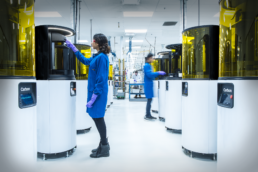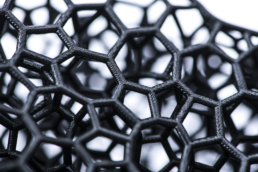Joe DeSimone: “We’re changing a 7,000-year-old production technology“
Carbon, an American company, is well known for its innovative approach to additive manufacturing and for its prominent investors such as Google. Co-founder Joe DeSimone talks about revolutionizing 3D printing, three-figure growth rates and the first technological break with the noble art of casting in 7,000 years.
By Erik Holm
March 2015 After a TED talk, Dr Joe DeSimone stepped into the international spotlight. On the stage, the American chemistry professor, co-founder and CEO of Carbon presented an entirely new approach to additive manufacturing while a sphere in a complex lattice structure was slowly pulled out of a reservoir of red resin.
The sphere cannot be made using traditional production technology and resembles something from the future. And there’s a good reason for this. The basic idea behind Carbon is inspired by the movie Terminator 2, says DeSimone, and he shows a clip of the robot T-1000 rising from a pool of glistening metallic fluid.
Fast forward to the end of September 2019. The TED talk video has more than 3.6 million views on YouTube and Carbon (prev. Carbon3D) has significantly developed the technology. Joe DeSimone himself has become a bit of a rock star in the world of additive manufacturing after a number of remarkable products and his promise to change additive manufacturing forever.
“Our vision hasn’t changed since then. Our vision was to shift additive manufacturing from a moderate prototype industry worth almost USD 8 billion to a global injection-moulding business worth more than USD 300 billion. What has taken us by surprise is how quickly things are developing and how hard it has been,” says Joe DeSimone.


USD 600 million
We manage to catch DeSimone on his phone early one morning in Redwood City, just south of San Francisco. This is where Carbon is headquartered, in the heart of Silicon Valley. From here, he can look back on an incredible story of growth since the start-up five years ago, featuring three-figure growth rates.
So far, Carbon has raised over USD 600 million in capital from, among others, Sequia and Google Ventures. The company has almost 500 employees in 14 different countries. By the end of 2019, they will have 1,000 printers installed, which are available via a subscription scheme. According to DeSimone, the company is valued at USD 2.46 billion, making Carbon one of the most valuable companies in 3D printing.
“We’ve come much further than I ever thought possible. And it’s obvious that we’re in the midst of something that can become much bigger. We’re well underway with our efforts to move 3D printing into the enormous injection-moulding market,” says Joe DeSimone, who’s on the phone from California.
Light and oxygen
Carbon’s technology works by exploiting the properties of ultra violet light and oxygen to materialize elements from a reservoir of different resins. Chemically speaking, light can transform a liquid into a solid. Oxygen, on the other hand, can stop this process. Light and oxygen are polar opposites, and by controlling this balance using advanced software and patented printers, Carbon can form components, for example for the motor industry, the dental industry and ordinary consumer products, such as sporting goods. Carbon calls this process CLIP, Continuous Liquid Interface Production.
Among the products that have gained the most public interest is a flexible and strong lattice construction for a midsole used in Adidas running shoes. Carbon has also created new solutions for shock-absorbent sports helmets, kitchen appliances and components for NASA, in close cooperation with customers, says Joe DeSimone.
In August, Carbon announced its partnership with the Specialized bicycle company, where the objective is mass production of saddles called the S-Works Power Saddle. The saddle is made up of 14,000 struts in a lattice construction to optimize comfort and stability for the cyclist. And finally, components produced by Carbon are being used by the American automotive industry for the first time. For example in the legendary F150 Ford pick–up; the most sold car in the US for many years.
“3D printing has existed for 30 years, but we’re the first to create digitally printed components for finished vehicles built in Detroit. Last year, the Adidas running shoes were the biggest volume of finished products ever created by a 3D printer, and this year we’re increasing this production tenfold. No other AM technology comes close to these numbers,” says Joe DeSimone.
He admits that German industry has been using 3D printed components for much longer than their American competition, but he maintains that there is a big difference between Carbon’s technology and traditional 3D printing, which he’s referred to many times as 2D printing over and over again.
“AM – especially in metals – is fantastic when it comes to a small number of units with high costs, such as we see in aviation, and the Germans have been very progressive. But polymer materials are for day-to-day products and they’re used everywhere. Making new parts in polymer costs a lot of capital to start and requires production of a large number of units. We’ve successfully introduced this technology to an enormous market. And our technology has become a game changer.”
To no one’s surprise, Joe DeSimone expects Carbon to continue its steep growth curve. According to him, Carbon has a long list of products in the pipeline. Products that will compete with traditional injection moulding and make it possible for customers to introduce new types of high-performance products that cannot be produced by injection moulding. Many of these new products were developed in a timespan of months, instead of years, he points out.


Re-using materials
Many customers are focusing on innovation as a way of reducing their overall use of materials in the hunt for more sustainable solutions. Thanks to this, Carbon can re-use several of its materials in new products. As he says, Carbon can re-use all the materials in two of its largest product groups; running shoes and dental products.
“Only we can realize this market. We print quickly, we use advanced software, and we’ve had a breakthrough in materials. For example, we now use high-quality elastic materials for the motor industry,” says DeSimone.
He’s hard pressed to guess where Carbon will find itself in five years’ time, but he’s very optimistic:
“Five years is a long time for a young company like ours. But we’re quickly moving into a market that’s basically still using a technology invented 7,000 years ago. We’re changing that.”
Joseph DeSimone, born in 1964, received a BSc in chemistry from Ursinus College and a PhD from Virginia Tech. In 2013, DeSimone co-founded Carbon and is now its CEO. Carbon combines molecular science with hardware and software technology in order to promote the AM industry. Throughout his career, Joe has published more than 350 scientific articles, won a host of awards and has almost 200 patents in his name, as well several pending applications. Joe DeSimone previously founded companies such as Micell Technologies, Bioabsorbable Vascular Solutions and Liquidia Technologies. He lives in California with his wife.

